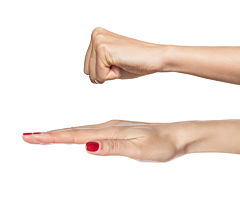 Since the 1970's, studies have shown that Mindfulness Based Stress Reduction (MBSR) is an effective tool to lower the stress of the practice of medicine and prevent physician burnout.
Since the 1970's, studies have shown that Mindfulness Based Stress Reduction (MBSR) is an effective tool to lower the stress of the practice of medicine and prevent physician burnout.
Jon Kabat-Zinn and the pioneers at U Mass have proven that physicians who take their eight week meditation and yoga training have superior resilience skills and subsequent studies over the last 40 years have repeatedly confirmed their initial observations.
In reviewing this literature, three big questions come to mind for most doctors.
1) What is mindfulness anyway?
2) Just how does mindfulness cause its therapeutic effect?
3) Is eight weeks of meditation training the ONLY way to be mindful at work?
~~~~~~~~~~~~~~~~
Become the Eye-Of-The-Storm in Your Practice Day
Our Evidence-Based, Single-Breath Mindfulness Technique
One Minute Mindfulness Online Training for Physicians
Learn More and Get Started Now
~~~~~~~~~~~~~~~~
Let me share my answers to these questions, coming from three different levels of experience:
- My own personal mindfulness practice
- One-on-one coaching work with hundreds of burned out doctors
- Teaching mindfulness to thousands of physicians in live trainings
 The Mechanics of Mindfulness
The Mechanics of Mindfulness
First, let's get clear on a definition of mindfulness. Here is a commonly accepted one: "Being present to what is happening here and now. Releasing thoughts and feelings that keep you from this present moment, without judgment."
The ultimate result of being mindful is you give this moment, this person in front of you, this task, your Undivided Attention.
Quick question:
Have you ever had any of these experiences?
a) There but not all there ...
You are in the room with a patient ... you sitting in front of them, conducting a history and exam ... but you aren't really there.
You are physically in the room, but your mind is distracted by worrying about a sick patient you saw this morning (the past) or wondering if you will be able to get out of the office at 5:30 because your son has baseball practice.
b) Hijacked by negative emotions
You are chugging through your practice day, but you can't help but fume about Obamacare and the loss of physician autonomy. You find yourself venting and distracted by how things used to be and how much the practice of medicine has changed ... for the worse.
Do either of these feel familiar?
When I ask these questions to a group of physicians in a live training ... all the hands will go up. These are common experiences for most practicing physicians. And they are the opposite of being mindful.
In each case above your attention is divided. You are distracted from the task at hand by thoughts and feelings.
Why is this important?
Because distraction by thoughts and feelings -- this mind-less-ness -- is a force multiplier for Physician Burnout
Dealing with sick, scared, suffering and dying patients is draining all by itself. Throw in distraction by negative emotions like worry, anger, frustration, righteous indignation ... and you can easily double the energy drain.
Mindfulness is incredibly valuable, because it brings the energy drain of non-supportive thoughts and feelings to a screeching halt.
~~~~~~~~~~~~~~~~
Become the Eye-Of-The-Storm in Your Practice Day
Our Evidence-Based, Single-Breath Mindfulness Technique
One Minute Mindfulness Online Training for Physicians
Learn More and Get Started Now
~~~~~~~~~~~~~~~~
What palliative care can teach us about physician burnout
Understand that there is a huge lesson from pain medicine to those of us wanting to lower our stress levels. In pain medicine and palliative care, we realize there are two things going on in our patient.
1) The physical sensation of pain
2) Our emotional reaction to that physical sensation = suffering
Pain management is our attempt to separate the two, so that a patient can be in pain and not suffer.
... In burnout and job related stress the two simultaneous events are
1) The repetitive tasks of your job
2) Your negative emotions/feelings about these repetitive tasks = suffering
When you are busy and behind schedule ... and at the same time find yourself in the throes of feelings like frustration or righteous indignation or blind rage - you are suffering. You are at least doubling the energy drain in that moment compared to if you were simply doing your job without all those feelings.
Mindfulness is the tool to separate the two.
============
Becoming the eye of the storm

With an effective mindfulness practice you can notice when you are distracted by thoughts and feelings and release them quickly and effectively -- without judging yourself in the process. You really can become the eye of the storm in your office day. You can get your tasks done -- with maximal focus and minimal suffering -- when you breathe and release non-supportive thoughts and feelings in your day as they come up.
Mindfulness is the emergency brake on physician burnout
As a physician burnout coach, I consider mindfulness to be a key First Aid tactic. It eliminates suffering and stops the downward spiral immediately. It is the first burnout prevention tool I teach all of my clients.
============
Is meditation the only path to mindfulness?
The answer is a resounding "No". There are many paths to being present and developing the focus of your undivided attention. One common component of all paths to mindfulness is connection with your breath.
And I want you to understand you already know how to do this.
Let me give you a common example.
Remember the last time you saw one of your really challenging patients? (my placeholder name for my tough patient is always Mavis)
When the day of Mavis' appointment finally arrives and you have your hand on the doorknob of her exam room ... what are you going to do before you enter the room ... naturally and automatically?
Right ... take a deep breath. Why are you doing that? Most likely to be centered, focused and present. You know you will need your undivided attention ... because this is Mavis after all.
This is native human mindfulness behavior. We all do this whenever we need to be fully present, without a single mindfulness or meditation lesson. Focusing by using your breath is a normal part of being human.
 Let's go a little deeper
Let's go a little deeper
Try this the next time you are hijacked by worry or frustration at work
- Notice you are having the unsupportive thoughts or feelings - if you look closely you will see you are actually holding on to them
- Make a super tight fist and take a big breath in ... a breath all the way up to the top of your head
- Exhale, open your fist and LET GO of the thoughts and feelings
- Refocus on what is right in front of you
This technique works for many physicians. NOTE: You can make the fist by your side or even in your pocket if you are concerned other people might notice.
This is one of many research proven relaxation techniques that will lower your stress levels and prevent physician burnout without a six week commitment to meditation classes.
Here at TheHappyMD.com we developed the Squeegee Breath technique and created the One Minute Mindfulness Online Training - which is research proven with a panel of 24 volunteer physicians.
One of the keys to the Squeegee breath and other non-meditation mindfulness tools -- is you perform the skill while you are on the job - when you need it the most
Meditation is often performed during off work hours in a site separate from your office or hospital. It can be difficult to translate the centered experience of this formal meditation to dealing with stress in your day as it is happening.
In my experience, learning a single breath technique for fast stress relief, followed by meditation training when your energy levels have recovered, often produces a additive effect on your ability to release and recenter at work.
Your breath allows you to release the negative emotions you are feeling in this moment and simultaneously connects with how it felt at the end of your last meditation session. They add to each other to produce even deeper levels of centered presence ... no matter what is going on around you.
==========
Now its your turn
I strongly recommend mindfulness training for all physicians and other healthcare providers for the following benefits
- Release and refocus at any time in your work day
- Avoid hi-jack by negative emotions
- Stop the energy drain of your feelings about work
- Provide higher quality, more centered care and build deeper connection with your patients, your team and your colleagues
For the fastest results I recommend starting with a single breath technique at work and expanding to the Kabat-Zinn MBSR training at a later date.
- Use this link if you would like to learn more about our One Minute Mindfulness Program and the Squeegee Breath ...
- Here is the link to the study proving its effectiveness
===========
PLEASE LEAVE A COMMENT:
What is your mindfulness practice and what difference has it made in your practice of medicine?


